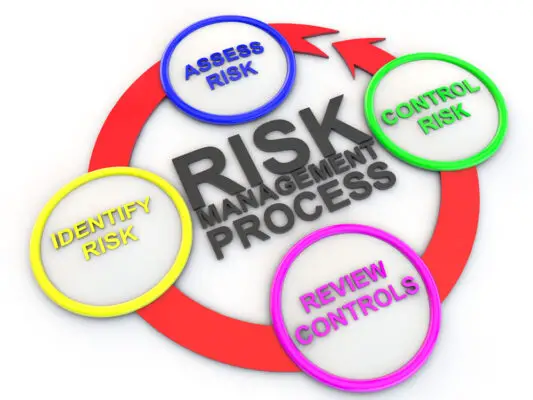Risk tolerance is a concept in finance and investing that refers to the uncertainty an investor is willing to withstand in pursuing potential gains. In a corporate setting, risk tolerance is defined by the organization’s willingness to accept risk to achieve its strategic objectives.
Considering the potential impact on stakeholders and its reputation. It is a key component in decision-making processes related to investments, financial planning, and risk management.
Risk tolerance can vary significantly from one individual or organization to another, and it is influenced by several factors, including:
Financial Situation and Goals: An investor with a solid financial foundation and long-term growth goals may be willing to take more risks than an individual with a less stable financial situation or short-term financial needs.
Age: Typically, younger investors are more able to recover from potential financial losses over time and hence have a higher risk tolerance, while older individuals nearing retirement may have a lower risk tolerance.
Knowledge and Experience: Investors with a good understanding of financial markets and investment strategies or who have experienced ups and downs in the markets may have a higher risk tolerance.
Psychological Factors: Some individuals are naturally more prone to risks, while others prefer safety and predictability.
Understanding risk tolerance is essential because it helps individuals and organizations make investment or strategic decisions that align with their financial goals and comfort with risk.
For example, an investor with a high-risk tolerance might be more comfortable investing in high-risk, high-reward assets like stocks. In contrast, investors with low-risk tolerance might prefer safer investments, such as bonds or money market funds.
Investment advisors typically use risk tolerance questionnaires or surveys to understand their client’s risk tolerance and to make suitable investment recommendations.
Similarly, organizations often develop risk management frameworks defining risk tolerance levels.
Understanding one’s risk tolerance is crucial for effective portfolio management and achieving long-term financial goals.
To determine their risk tolerance, investors must consider various factors such as age, income, financial obligations, investment objectives, and personal preferences.
Additionally, it is essential to understand the different types of investment risks and how they relate to an individual’s risk tolerance.
A thorough understanding of risk tolerance can help investors make informed decisions about their investments while balancing the potential for higher returns with the possibility of greater losses.
In this article, we will explore the concept of risk tolerance in detail and discuss its significance in managing investments effectively.

Definition of Risk Tolerance
An individual’s risk tolerance level can be influenced by various factors such as age, income, investment goals, and personal circumstances. For instance, younger individuals may have a higher risk tolerance due to their long time horizon for investments, while older individuals nearing retirement may have a lower risk tolerance.
Examples of high-risk tolerance investors include those willing to invest in emerging markets or start-up companies with high growth potentials despite the high risks involved.
On the other hand, low-risk tolerance investors tend to choose safer investments, such as government bonds or blue-chip stocks that offer lower returns but are less volatile.
It is essential for investors to understand their risk tolerance levels before making any investment decisions. Investors should avoid making decisions solely based on their emotions or short-term market fluctuations and instead focus on long-term financial goals that align with their risk profile.
Understanding risk tolerance helps create a well-diversified portfolio that balances risks and rewards effectively.
Investors and organizations must find an optimal balance between their desired returns and their ability to handle potential losses without compromising financial stability.
How to Determine Your Risk Tolerance
Risk tolerance refers to the level of risk an individual or organization is comfortable with their investments. Age, financial goals, income stability, and personal values can all influence a person’s risk tolerance.
Assessing factors that impact one’s risk tolerance can be a complex process. It requires understanding objective and subjective factors that influence investment decisions.
Objective factors include financial resources, net worth, income stability, and anticipated investment returns. Subjective factors may include an individual’s beliefs about investing, their emotional response to market volatility, and past experiences with financial loss or gain.
Seeking guidance from a financial advisor can help determine your risk tolerance. Advisors can explain how different investment strategies align with your unique needs and goals.
They can also help you understand how emotions impact your decision-making during market volatility.
Seeking guidance from an experienced financial advisor can help ensure you make choices that align well with your unique needs and goals over time.
Types of Investment Risks
One type of investment risk is market volatility, which refers to price fluctuation within a given market. Various factors, including economic conditions, political events, and natural disasters, can cause this.
Market volatility can have both positive and negative effects on investments. While it can lead to significant gains for those who can accurately predict market movements, it can also result in substantial losses for unprepared people.
Another necessary type of investment risk is concentration risk, which occurs when an investor holds a large portion of their portfolio in one particular asset or sector.
This strategy may result in higher returns if that asset performs well, but it also increases the potential for loss if it does poorly. To mitigate this risk, investors may diversify their portfolios by investing in multiple assets across various sectors.
Finally, credit risk is another critical factor to consider when investing. This refers to the possibility that a borrower will default on debt payments or fail to meet other financial obligations.
Credit ratings can help investors assess the credit risk associated with different investments and make informed decisions based on these ratings. Lower-rated bonds generally carry higher credit risks but offer higher yields as compensation for this added risk.
Understanding the types of investment risks is essential for any investor looking to build a successful portfolio.
Balancing Risk and Reward
Achieving a balance between the potential rewards and drawbacks of investing can be likened to walking a tightrope, as both require careful consideration of one’s footing and surroundings to avoid falling.
Investors must evaluate the risk-reward tradeoff before making any investment decisions.
To achieve this balance, investors need to implement effective risk management strategies. One way investors can manage their risks is by diversifying their portfolios.
Diversification involves spreading investments across different asset classes, such as stocks, bonds, commodities, or real estate, which helps reduce exposure to any single investment.
Another strategy is setting stop-loss orders on individual positions. Stop-loss orders set predetermined exit points for an investor’s position to limit losses in case of unexpected market movements.
Investors may also use various risk management tools, such as options and futures contracts to hedge against potential losses while retaining exposure to potential gains.
Finding the right balance between risk and reward requires discipline and patience from investors willing to invest the time and effort needed for successful investing.

The Importance of Understanding and Managing Your Risk Tolerance
Understanding and effectively managing investment risks is crucial for long-term financial success. Failure to do so can result in significant losses, which can be challenging to recover.
Investment Strategy Alignment: Your risk tolerance directly influences the types of investments you should consider. For instance, if you have a high-risk tolerance, you might be more comfortable with investments such as stocks or real estate with the potential for high returns and volatility.
On the other hand, if your risk tolerance is low, you might prefer investments such as bonds or certificates of deposit that offer more stability, even if the potential returns are lower.
Long-term Financial Goals: Understanding your risk tolerance can help align your investment strategy with your long-term financial goals.
For example, if you’re saving for retirement or a child’s education, you might be willing to take on more risk in your investments to achieve a higher return over the long term.
Emotional Comfort: By investing in line with your risk tolerance, you can ensure that you’re comfortable with the level of risk in your portfolio. This can help prevent panic selling during market volatility and encourage more disciplined, long-term investment behaviour.
Preventing Financial Loss: Understanding your risk tolerance can help you avoid investments that are too risky for your comfort level, potentially saving you from severe financial losses.
Asset Allocation and Diversification: It plays a key role in determining your asset allocation strategy, i.e., how you distribute your investments across different asset classes, such as stocks, bonds, and cash.
This, in turn, influences the diversification of your portfolio, which is a key strategy for managing investment risk.
Risk Capacity: Understanding your tolerance also involves understanding your risk capacity, which is the amount of risk you can afford to take, given your financial situation and goals.
Balancing risk tolerance and risk capacity can help ensure you don’t take on more risk than you can handle.
As such, it is essential to understand one’s tolerance, which refers to the level of risk an individual is willing and able to take on. Factors affecting risk tolerance include age, income level, investment goals, and personal financial situation.
This means you can tailor your investment strategy based on what you are comfortable with and what makes sense given your financial goals.
In addition, effective risk management techniques such as diversification can help mitigate the impact of market fluctuations on your portfolio.
Frequently Asked Questions
What are some common mistakes people make when assessing their risk tolerance?
Assessing risk tolerance is a critical step in any investment decision-making process. However, emotional biases and overestimating abilities are common mistakes when assessing risk tolerance.
Emotional biases like fear or greed can cloud judgment and lead to irrational decisions.
Overestimating abilities such as knowledge or experience can also result in taking on more risks than one can handle.
To avoid these pitfalls, one must understand the level of risk that one can comfortably handle and stay disciplined in adhering to this level.
Finding the right balance between risks and rewards requires careful assessment of one’s capabilities without letting emotions take over the decision-making process.
How does age affect one’s risk tolerance?
Age is a significant factor that affects an individual’s risk tolerance.
Younger individuals tend to have a higher risk tolerance as they have more time to recover from any potential losses and can afford to take risks with their investments.
As such, they may be more inclined towards long-term investments with higher returns but greater risks.
On the other hand, older individuals closer to retirement age may prefer short-term investments that provide steady and reliable returns while minimizing the risk of losing their savings.
Investors must consider their age when assessing risk tolerance and making investment decisions accordingly.
Is it possible to increase or decrease your risk tolerance over time?
Like how a seasoned sailor becomes more comfortable navigating rough waters over time, individuals can increase their risk tolerance with experience.
One way to improve risk tolerance is by diversifying one’s portfolio and spreading investments across various asset classes to reduce overall risk.
Additionally, adopting an investment strategy that aligns with personal goals and values can help manage risk perception.
For example, investing in socially responsible companies may provide a sense of security, knowing that investments support ethical practices.
However, it is important to note that increasing risk tolerance should not be done recklessly or without proper research and understanding of the potential consequences.
Rather, taking calculated risks based on informed decisions can lead to positive outcomes in the long term.
Are any specific industries or sectors considered higher risk than others?
For instance, the technology sector is often seen as a high-risk industry due to its volatile nature and fast-paced innovation, which can lead to sudden changes in stock prices.
Similarly, the healthcare and biotech industries also carry significant risks due to their reliance on regulatory approvals for new drugs and treatments.
On the other hand, more stable industries such as utilities or consumer staples are generally considered a lower risk due to their predictable cash flows and steady demand regardless of economic conditions.
Understanding industry-specific risks is important in developing a successful investment strategy that aligns with one’s risk tolerance.
How do one’s values and beliefs impact their risk tolerance?
Exploring the impact of personal values and beliefs on an individual’s risk tolerance sheds light on a complex interplay of factors that shape one’s attitude towards taking risks.
Ethical considerations are often at the forefront of decision-making, leading some to adopt a conservative approach while others may be willing to take on greater risks for financial gain.
Cultural influences can also play a role, with individuals from collectivist cultures being more risk-averse due to their emphasis on community and family well-being.
Financial goals and family responsibilities further complicate matters as individuals balance their desire for financial growth with the need to provide for loved ones.

Conclusion
Risk tolerance refers to an individual’s ability and willingness to take on financial risks when investing. Determining your risk tolerance before making investment decisions is important, as it can greatly impact your portfolio’s performance.
Various factors influence risk tolerance, such as age, income, financial goals, and personal preferences. Understanding your risk tolerance is crucial in finding the right balance between potential rewards and risks.
When investing, there are different types of risks that you should be aware of: market risk (the possibility of losing money due to changes in the stock market), interest rate risk (the effect of fluctuating interest rates on bonds and other fixed-income securities), inflation risk (when inflation reduces the purchasing power of your investments), liquidity risk (difficulty selling assets quickly without significant loss), and more.
Balancing these risks with potential rewards is key to building a successful investment strategy.
Managing your risk tolerance is essential for achieving long-term financial success. While some may enjoy taking high-risk investments for the chance of greater returns, others may prefer a more conservative approach.
Regardless of your path, understanding your tendencies towards investment risks will help you make informed decisions that align with your financial goals.

Chris Ekai is a Risk Management expert with over 10 years of experience in the field. He has a Master’s(MSc) degree in Risk Management from University of Portsmouth and is a CPA and Finance professional. He currently works as a Content Manager at Risk Publishing, writing about Enterprise Risk Management, Business Continuity Management and Project Management.

